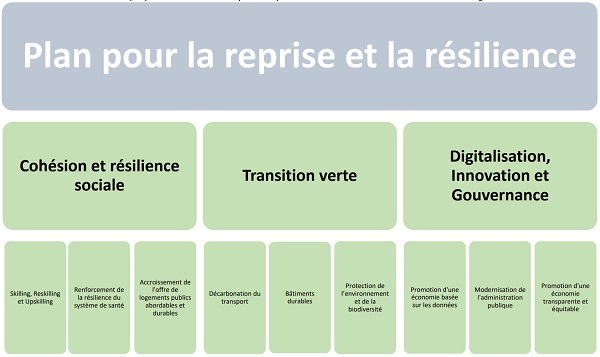 Structure of Luxembourg's recovery and resilience plan;
Credit: MFIN
Structure of Luxembourg's recovery and resilience plan;
Credit: MFIN
On Wednesday 10 March 2021, Luxembourg's Minister of Finance, Pierre Gramegna, presented the national recovery and resilience plan to the Government Council.
In close collaboration with the other ministries and administrations concerned, the Ministry of Finance has coordinated, over the past few months, the preparation of this document, which represents a key stage in the implementation of recovery efforts at the European level in the face of the COVID-19 pandemic.
Finance Minister Pierre Gramegna explained: “The government fully shares the objectives sought by the European recovery efforts, which strengthen solidarity between the Member States and provide a qualitative recovery which prepares the green and digital transition. It is indeed an essential initiative to support the extraordinary recovery effort that is necessary at European level, in a context of unprecedented crisis”.
Luxembourg's allocation under the Recovery and Resilience Facility, the centrepiece of the European Union's (EU) recovery plan, amounts to around €93 million and the projects pre-selected by the government are based on three pillars, namely: cohesion and social resilienc, green transition and digitalisation, innovation and governance. These pillars are part of the continuity of the government's action and reflect the priority of a recovery focussed on the dual green and digital transition.
The majority of the projects selected are included in the state budget for the financial year 2021 or in the multiannual financial programming for the period 2020-24 and relate to a total amount of €333 million, which exceeds the total European funds available to Luxembourg. This approach ensures that the pre-selected projects have the necessary maturity and will subsequently facilitate the implementation of the national plan for recovery and resilience.
The final selection of projects to be financed through the Recovery and Resilience Facility will be based on consultations with the European Commission which will start on Wednesday, in view of the upcoming legal transmission deadline of the plan for recovery and resilience (30 April 2021). The precise contribution to the dual climatic and numerical objective will depend on this final distribution. Luxembourg's Chamber of Deputies (Parliament) and the social partners will also be consulted in the coming weeks and these exchanges will help to guide the final content of the national plan.
Funds from other European stimulus programmes, such as REACT-EU or the Just Transition Mechanism, have not been taken into account under the recovery and resilience plan. However, the measures identified by the government to be financed through the various European programmes form a coherent set of measures in accordance with the holistic approach adopted by the government to allocate the budgets at its disposal under European funds. The funds allocated to Luxembourg under REACT-EU will thus go towards cofinancing the Large Scale Testing initiative, the partial unemployment scheme, the costs related to vaccination against COVID-19 and initiatives promoting the green transition.
Minister Pierre Gramegna concluded: “This draft 'Recovery and Resilience Plan' of Luxembourg is fully in line with the continuity of government action and carries the ambition to promote ecological and digital transitions, while focusing on emphasis on social cohesion and the promotion of a modern and attractive economic environment. I am delighted that the government is submitting a project before the legal deadline of 30 April 2021. This now allows consultations to be launched with the European Commission as well as with other stakeholders with a view to finalising the plan".








